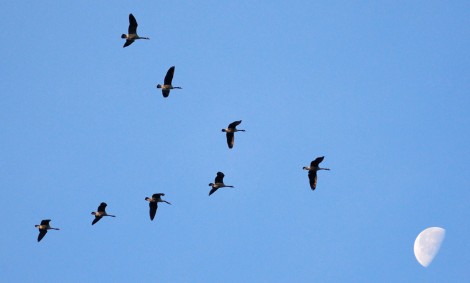 All this summer, I watched many flock of geese fly over my house in their familiar “V” formation. Consider what some believe about why geese fly the way they do. And then, consider what we can learn from them …
All this summer, I watched many flock of geese fly over my house in their familiar “V” formation. Consider what some believe about why geese fly the way they do. And then, consider what we can learn from them …
- As each bird flaps its wings, it creates uplift for the bird immediately following. By flying in “V” formation, the flock adds at least 70% greater flying range than if each bird flew on its own.
Successful teams share a common direction and sense of community, and can get where they are going more quickly and easily, because they are traveling on the thrust of one another.
- When a goose falls out of formation, it suddenly feels the drag and resistance of trying to go it alone – and quickly gets back into formation to take advantage of the lifting power of the bird in front.
There is no “I” in team. Successful teams stay together and learn to work well together by building on the strengths of each person on the team. There is great advantage to this – for everyone involved.
- When the lead goose gets tired, it rotates back in the wing and another goose flies point.
Successful teams share the work. Each person knows the others’ jobs and can jump in at any time, as needed. Each can lead and each can follow. The team works together and gets the job done – every time, without fail.
- Geese honk from behind to encourage those up front to keep up their speed.
Successful teams cheer their colleagues on, and celebrate the successes of their teammates.
- Finally, when a goose gets sick or hurt, and falls out of formation, two other geese fall out with that goose and follow it down to give help and protection. They stay with the fallen goose until the crisis has passed, and only then do they launch out with another formation to catch up to their group.
Successful teams stand by one another, offering support, assistance, and help when needed. Teammates know they can count on one another. There is a give and take in the relationship, a respect for one another, and a knowing that we all, at one time or other, “need.”
I’d love your thoughts on this one!
Stay tuned. My next few blogs will be about building a successful team. It is, perhaps, the single, most important work of the leader of an organization.

There is no “I”. Indeed! The most important thing to recognize. I love your analogy , comparing a team of teachers to a flock of geese. Thank you for a great post!